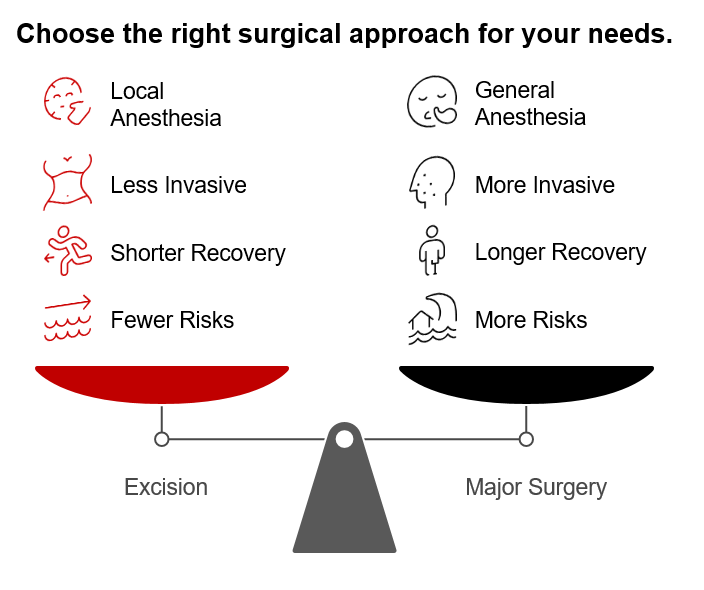Skin Cancer Excision Procedure
What Happens During a Skin Cancer Excision Procedure
Just hearing the words “skin cancer” can feel overwhelming. If you or someone you love has been diagnosed, one of the first questions that comes to mind is likely, “What happens next?” One of the most common and effective treatments is skin cancer excision, a procedure designed to remove cancerous skin cells before they spread. And the good news? It is often quick, safe, and highly successful.
If you’re feeling nervous, that’s completely normal. But understanding what to expect during this procedure can take away a lot of that fear. Whether you’re preparing for your own appointment or supporting a loved one, here’s a simple and straightforward guide to what really happens during a skin cancer excision.
First Things First: Why Excision?
Excision is often recommended when a biopsy confirms the presence of basal cell carcinoma, squamous cell carcinoma, or even early-stage melanoma. It involves surgically removing the cancerous tissue, along with a small amount of surrounding healthy skin to make sure all the abnormal cells are gone.
Basal cell carcinoma is the most common type and grows slowly. Squamous cell carcinoma is more likely to spread but is also treatable if caught early. For more aggressive forms like melanoma or rare types such as Merkel cell carcinoma, excision is often the first step in a broader treatment plan.
Understanding the Role of Excision in Skin Cancer Care
1. What Stage of Cancer Can Be Cured by Excision
Excision is most effective for early-stage skin cancers, such as stage 0 (in situ) or stage 1, where the cancer is still localized. At this point, removing the tumor and a small margin of healthy tissue often results in a complete cure. If detected early, excision can prevent the need for more aggressive treatments.
2. Which Age Groups Are More Suitable
Excision is safe and suitable for all age groups, from young adults to the elderly. Older adults are more likely to need it due to higher sun exposure over time. However, even younger patients benefit from early intervention when suspicious skin changes are found.
3. Comparison of Surgery and Excision
Excision is a form of minor surgery, typically done under local anesthesia in an outpatient setting. In contrast, major skin surgeries might require general anesthesia, longer recovery, and hospitalization. Excision is less invasive, has fewer risks, and is highly effective for small, non-spreading skin cancers.

4. Importance of Excision in Skin Cancer
Excision is crucial because it allows complete removal of the cancerous tissue while minimizing damage to surrounding skin. It also enables lab testing of margins to ensure the cancer hasn’t spread. This improves outcomes and reduces the chance of recurrence.
5. What Makes Excision Procedure More Achievable
Excision is widely available, cost-effective, and usually done in a clinic setting without hospitalization. It doesn’t require extensive recovery time and is covered by most insurance plans. The simplicity and reliability of the procedure make it a go-to treatment for early skin cancer.
The Day of the Procedure: What to Expect
Let’s walk through what usually happens when you go in for a skin cancer excision.
1. Preparation and Numbing the Area
The first step is making sure you’re comfortable. The doctor will clean the area and then apply a local anesthetic. This numbs only the part of the skin where the excision will take place, so you’ll stay awake but won’t feel pain during the procedure. If you’re especially anxious, don’t hesitate to let your doctor know. Some clinics also offer consultation services to help you feel prepared.
2. Excision of the Skin Cancer
Once the area is numb, the doctor uses a scalpel to carefully remove the cancerous tissue along with a small margin of normal skin around it. This “safety margin” helps ensure no cancer cells are left behind. The size and depth of the cut depend on how large and deep the cancer is.
If you’re dealing with skin cancer on the scalp or ears, the approach may be slightly modified due to the delicate nature of those areas. In some cases, a scalp biopsy might have already been performed to understand the extent of the cancer before the excision.
3. Closing the Wound
After removing the tissue, the doctor will close the wound. For smaller excisions, stitches may be all that’s needed. For larger or deeper cuts, additional techniques like skin grafts or flap closures may be used. Either way, the goal is to help your skin heal as neatly and quickly as possible.
Your physician will likely give you detailed aftercare instructions. You may also be guided to minor surgical services or even home care visits if needed.
What Happens to the Removed Tissue?
The excised tissue is sent to a lab where a pathologist examines it under a microscope. This helps confirm that all the cancerous cells have been removed. If the margins are clear, you’re in the clear. If not, the doctor may recommend a follow-up excision.
After the Procedure: Healing and Monitoring
Recovery is usually straightforward. Most people can go home the same day and resume normal activities within a few days. You might be advised to avoid strenuous movement for a short period, especially if the wound is large.
Your follow-up care may include wellness exams or regular skin checks to watch for any signs of recurrence. If you’re concerned about scarring, your physician may recommend skin-friendly treatments and healing ointments.
Support Beyond the Procedure
Being diagnosed with skin cancer can take an emotional toll, but remember, you’re not alone. From outpatient care services to post-acute care like skilled nursing or assisted living, there are options to help you recover well.
If you’re interested in other related resources, check out more posts in our Health Blog or visit the full blog section for articles on conditions like hemorrhagic ovarian cysts, normocytic anemia, and infusion therapy